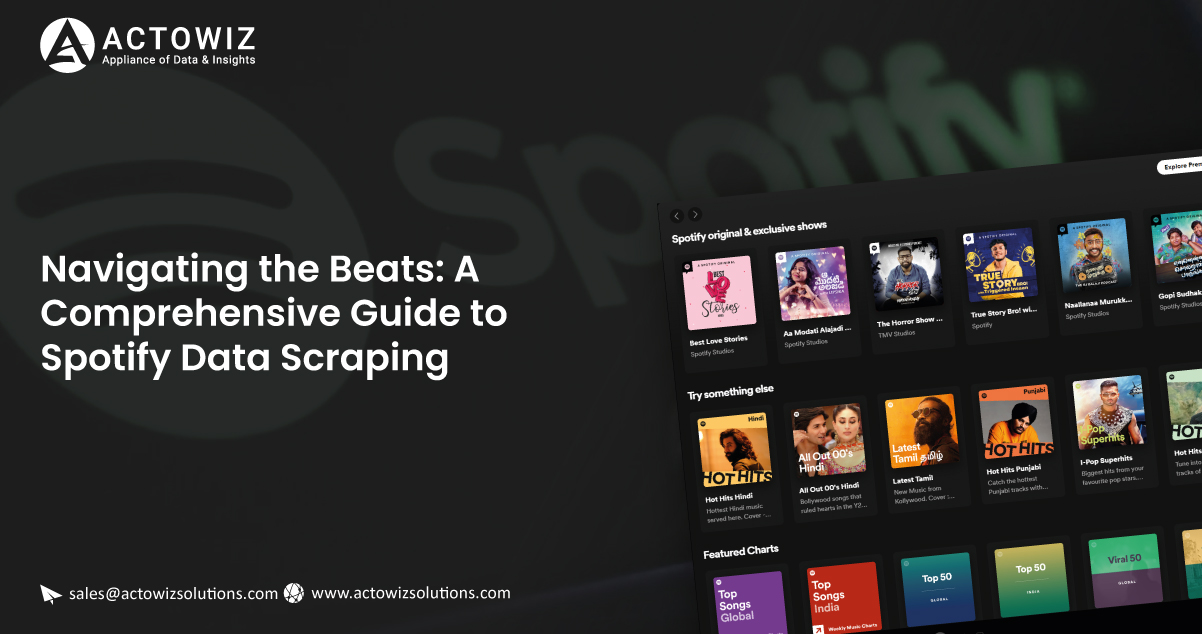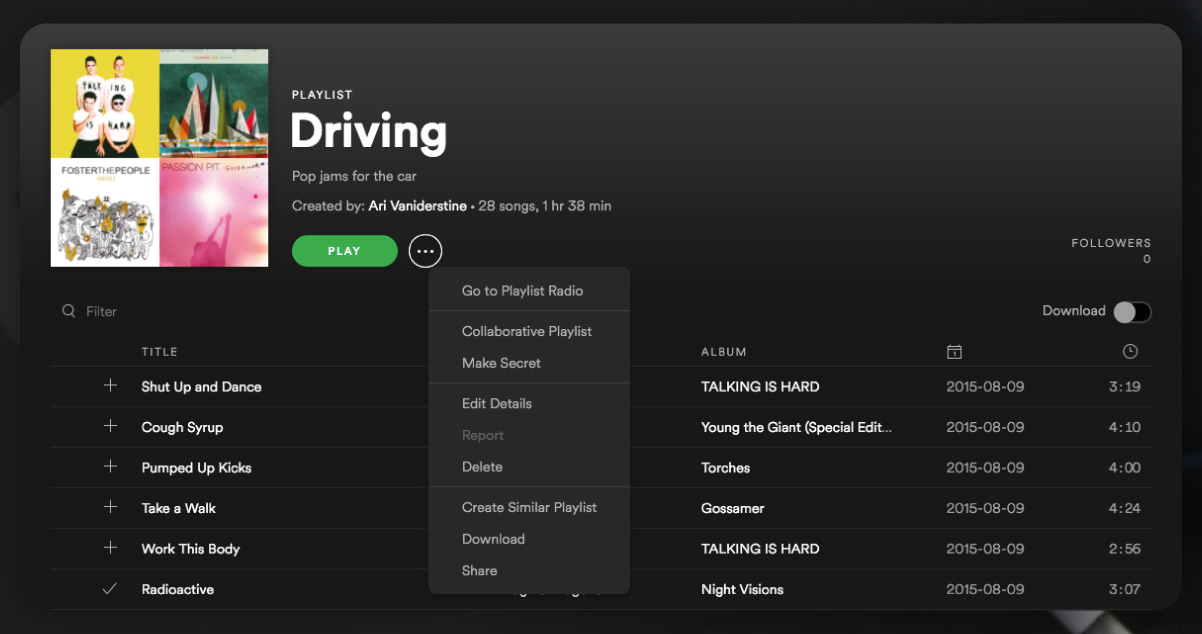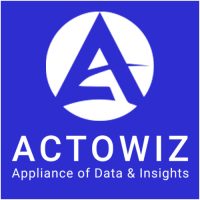Navigating the Beats: A Comprehensive Guide to Spotify Data Scraping

Introduction
In the ever-evolving landscape of music streaming, navigating the intricate web of user preferences, popular tracks, and burgeoning artists is essential for staying at the forefront of the industry. Spotify, a dominant global player in this space, is a treasure trove of invaluable data capable of empowering businesses, analysts, and music enthusiasts alike. This guide is a compass for delving into the intricacies of scraping data from Spotify.com, unveiling a realm of insights and possibilities that can redefine how we understand and interact with the vast musical universe. As we embark on this journey, we’ll explore the methodologies and tools required to extract meaningful data from Spotify, shedding light on trends, preferences, and emerging musical phenomena within this influential platform’s digital corridors. Join us in uncovering the keys to decoding the rhythmic patterns that shape the future of music streaming.
Understanding the Spotify API
The Spotify API serves as the central gateway for unlocking the wealth of music-related data within Spotify’s expansive repository. At its core, this API provides developers and enthusiasts the tools to integrate and interact seamlessly with Spotify’s vast musical ecosystem. Understanding its fundamentals is paramount for anyone harnessing the platform’s data-rich offerings.
Authentication Process
The first step in leveraging the Spotify API involves authentication. Developers must obtain client credentials, authenticate through the OAuth 2.0 protocol, and receive access tokens. This process ensures secure and authorized access to Spotify’s data, safeguarding user privacy and maintaining the platform’s integrity.
Endpoints
Spotify API utilizes specific endpoints that act as channels through which data is requested and received. Endpoints correspond to various functionalities such as retrieving track details, user information, playlists, and more. Each endpoint serves as a doorway to a specific data set, allowing developers to tailor their requests based on their informational needs.
Types of Data Available for Extraction
The Spotify API offers a diverse range of data for extraction, including but not limited to track details, artist information, album data, and user-generated playlists. This rich assortment enables developers to tailor their data retrieval to suit specific analytical or creative objectives, unlocking myriad insights into the world of music.
Setting Up Your Development Environment
To embark on the journey of scraping data from Spotify.com, it’s crucial to establish a robust development environment. Follow these steps to ensure a seamless setup:
1. Obtain API Credentials
Begin by creating a Spotify Developer account to access the Spotify API. Create a new application to obtain client ID and client secret credentials. These credentials serve as your key to authenticate and access the API.
2. Choose a Programming Language
Select a programming language that aligns with your preferences and project requirements. Python is a popular choice due to its versatility and the availability of libraries like Spotipy that simplify interactions with the Spotify API.
3. Install Necessary Libraries
If you’ve opted for Python, install Spotipy, a Python library specifically designed for interfacing with the Spotify API. Use the following command in your terminal or command prompt:
pip install spotipy4. Authenticate with Spotify API
Implement the OAuth 2.0 authentication process using your obtained credentials. This involves obtaining an access token that grants your application permission to interact with the Spotify API.
5. Create Your Development Environment
Set up a virtual environment to manage dependencies and isolate your project. This ensures a clean and organized environment for your Spotify data scraping endeavors.
With these steps, you’ll have a well-configured development environment, equipped with the necessary tools and credentials to seamlessly interact with the Spotify API and begin your exploration of musical insights.
Extracting Track Information
To extract valuable data on individual tracks from Spotify using the API, follow these steps:
1. Initialize Spotipy
Import the Spotipy library and initialize it with your API credentials. This establishes the connection to the Spotify API.

2. Search for a Track
Use Spotipy’s search function to find a specific track. Retrieve the track details, including its unique Spotify ID (URI).

3. Get Track Information
With the track URI, fetch detailed information about the track, covering essential data points.

4. Extract Audio Features
Obtain additional insights into the track by fetching its audio features, such as danceability and tempo.

By following these steps, you can effectively use the Spotify API to scrape comprehensive data on individual tracks, covering crucial details that span from track and artist information to nuanced audio features.
Analyzing User Playlists

Analyzing user playlists on Spotify unveils a rich tapestry of musical preferences and personal curation. Developers can employ effective methods to scrape and glean insights from these playlists by leveraging the Spotify API.
1. Retrieve User Playlists
Utilize the API to fetch a user’s playlists, providing a foundational step for deeper analysis. This involves authenticating with user permissions and accessing the list of playlists associated with a specific Spotify account.
2. Extract Playlist Details
Dive into each playlist to extract essential details, including the playlist name, description, total track count, and collaborative status. This information offers context about the playlist’s purpose and theme.
3. Fetch Track Listings
Iterate through the tracks in each playlist, extracting details such as track name, artist, album, and Spotify URI. This comprehensive track listing provides a granular understanding of the musical content within the playlist.
4. Analyze User-Generated Metadata
Explore user-generated metadata, such as playlist followers, creation date, and collaborative status. This metadata contributes to the broader understanding of the playlist’s popularity, longevity, and collaborative nature.
By employing these techniques, developers can scrape user playlists effectively and analyze the intricate details that define the user-curated musical experience on Spotify. This wealth of information enables businesses and enthusiasts to gain profound insights into user preferences and tailor their strategies accordingly.
Discovering Trends and Insights
Collecting and analyzing data in the music industry can provide valuable insights into trends, popular genres, and user behavior. Here’s how the collected data can be utilized to uncover trends and gain insights for businesses, marketers, and music enthusiasts:
Trend Identification
Genre Popularity:
Data Source: Analyzing streaming platforms, social media, and download statistics.
Application: Record labels and artists can identify the most popular genres and adjust their strategies accordingly. Marketers can target audiences interested in specific genres for more effective campaigns.
Emerging Artists:
Data Source: Social media engagement, streaming numbers, and online mentions.
Application: Record labels and talent scouts can identify rising stars early on. Businesses can collaborate with emerging artists for mutually beneficial partnerships.
Regional Trends:
Data Source: Geographical data from streaming platforms and concert ticket sales.
Application: Artists and businesses can tailor their content or promotions to specific regions. Marketers can target local audiences effectively.
User Behavior Insights:
Listening Patterns:
Data Source: Streaming platforms, radio play, and user playlists.
Application: Artists can understand when their audience is most active, allowing for strategic release timings. Marketers can optimize advertising schedules based on peak listening times.
Cross-Genre Preferences:
Data Source: Analysis of user playlists and cross-genre collaborations.
Application: Marketers can identify crossover opportunities between genres for targeted promotions. Artists can experiment with diverse styles to appeal to a broader audience.
Device Preferences:
Data Source: Device-specific streaming data (e.g., mobile, desktop, smart speakers).
Application: Marketers can optimize ad formats based on the preferred devices of the target audience. Artists can tailor their content for optimal listening experiences on specific devices.
Business and Marketing Applications
Personalized Recommendations:
Data Source: User listening history and preferences.
Application: Streaming platforms can provide personalized playlists and recommendations, increasing user engagement. Marketers can leverage personalized recommendations for targeted promotions.
Targeted Advertising:
Data Source: Demographic and behavioral data of users.
Application: Marketers can create highly targeted ad campaigns based on user demographics, preferences, and behaviors, leading to more effective and efficient advertising.
Partnerships and Collaborations:
Data Source: Analysis of collaborative projects and fan engagement.
Application: Businesses can facilitate partnerships between artists based on data-driven insights, maximizing the potential for successful collaborations. Marketers can leverage collaborations for joint promotions and campaigns.
How Actowiz Solutions Can Help in Scraping Spotify Data?
While scraping data from Spotify directly can be challenging due to its dynamic nature and anti-scraping measures, Actowiz Solutions can still be an effective partner. Here’s how they can help:
1. Custom Web Scraping Solutions
Actowiz’s developers can build tailored web scraping solutions designed explicitly for Spotify. They can handle:
Dynamic content: Actowiz can handle JavaScript-rendered content and dynamic URLs, overcoming Spotify’s attempts to prevent scraping.
Anti-scraping measures: They can bypass IP blocking, CAPTCHA challenges, and other anti-scraping techniques employed by Spotify.
Data extraction: Actowiz can extract the specific data points you need, such as song titles, artists, albums, genres, lyrics, user profiles, and more.
Scalability: They can handle large-scale scraping tasks without compromising data quality or scraping speed.
2. Data Cleaning and Processing
Actowiz can process and clean the scraped data to ensure its accuracy and usability. This includes:
Removing duplicates and inconsistencies: They can identify and eliminate duplicate data entries to ensure a clean and accurate dataset.
Data validation: Actowiz can verify the data against Spotify’s official API or other reliable sources to ensure accuracy.
Data structuring: They can format the data into the desired format, such as CSV, JSON, or Excel, for easy analysis and utilization.
3. Data Security and Compliance
Actowiz can ensure the security and compliance of your scraped data by:
Using secure servers and protocols: They store your data on secure servers and use encryption to protect it from unauthorized access.
Complying with data privacy regulations: They comply with relevant data privacy regulations, such as GDPR and CCPA, to ensure your data’s ethical and responsible use.
4. Ongoing Support and Maintenance
Actowiz provides ongoing support and maintenance for its solutions. This includes:
Monitoring and managing your scraping process: They ensure it runs smoothly without interruption.
Adapting to changes: Actowiz can adapt its solutions to changes in Spotify’s website or anti-scraping measures to ensure continued data collection.
Providing technical support: They provide technical assistance to answer any questions you may have about your scraping project.
5. Cost-Effectiveness
Actowiz offers cost-effective solutions compared to building and maintaining your scraping infrastructure. This allows you to access valuable data without significant upfront investment.
Conclusion
Actowiz Solutions can be a valuable partner in your Spotify data scraping project. Their expertise, technology, and services can help you overcome the challenges of scraping data from this dynamic platform and acquire the insights you need to achieve your business goals. For more details, contact us now! You can also reach us for all your mobile app scraping, instant data scraper and web scraping service requirements.
sources >> https://www.actowizsolutions.com/navigating-the-beats-to-spotify-data-scraping-guide.php
Tag : #SpotifyDataScraping
#SpotifyDataScraper
#ScrapeSpotifyData
#SpotifyDataCollection
#SpotifyDataExtraction

